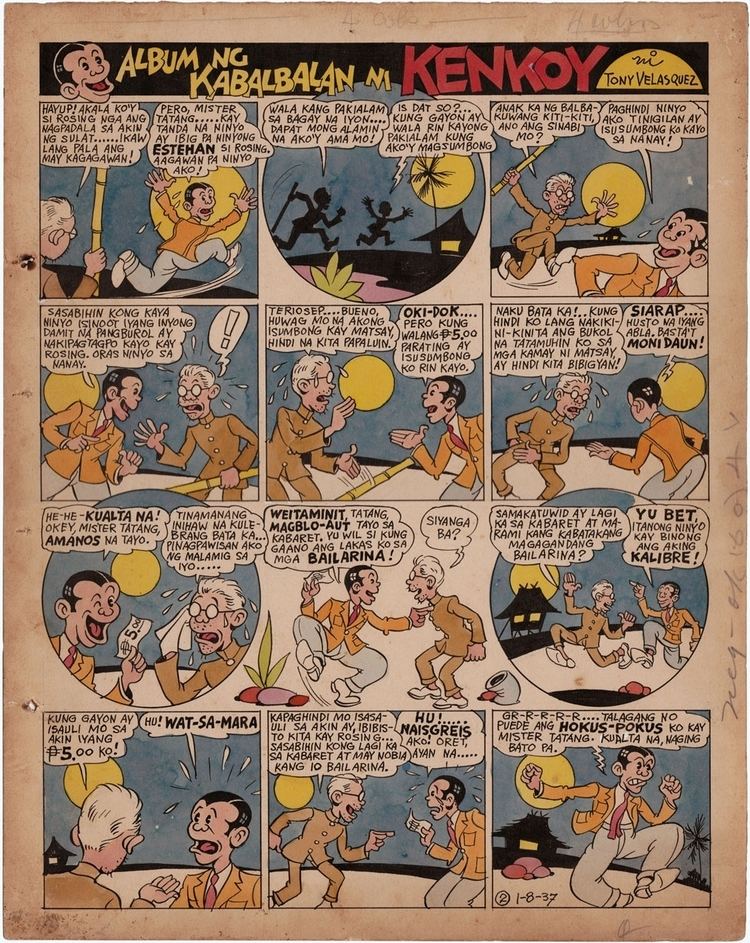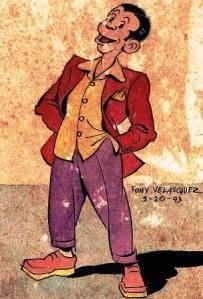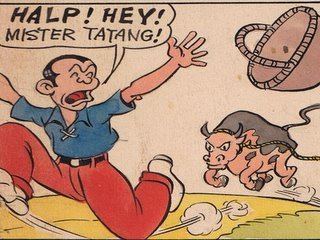Aliases Francisco Harabas | ||
Relatives Rosing (wife)Children:Dayunyor DyulieTsingDoyDalisyosaEtotNenePiching,Tsikiting Gubat Similar Bondying, Darna, Lastikman, Captain Barbell, Dyesebel | ||
Mr kenkoy mike hanopol
Francisco "Kenkoy" Harabas is a Philippine comics character created by writer Romualdo Ramos and cartoonist and illustrator Tony Velasquez in 1929. Velazquez continued the strip for decades after Ramos' death in 1932. Kenkoy was seminal to Philippine comics and thus Velasquez is considered the founding father of the industry. The term kenkoy has entered the Filipino language to mean a joker, jester, or a hilarious person.
Contents
- Mr kenkoy mike hanopol
- Mr kenkoy by mike hanopol
- Description
- History
- Influence on language
- Influence on music
- Influence on film
- References

Mr kenkoy by mike hanopol
Description

Kenkoy was a comedic character who wore a baggy pair of pants, suspenders and charol shoes, and had “ironed” or flattened hair.
The modern translation of his Tagalog surname "Harabas" is "reckless".
Filipino illustrator and cartoonist Nonoy Marcelo described Kenkoy as a “ludicrous portrait of the Filipino pathetically trying but barely succeeding in keeping up with his American mentors” (see American Period in Philippine History) and as the “Philippine’s first true pop icon”.

Although with a funny personality, Kenkoy courted Rosing, the Manileña (a woman from Manila) who represented the ideal and romanticized Filipino woman – a female who was timid, shy, kind, caring, prone to jealousy, and impeccable – garbed (like Philippine national hero José Rizal’s Maria Clara) in the traditional baro’t saya or the Sunday camisa (shirt) combined with the panuelo (kerchief), including the bakya (a pair of wooden clogs) footwear. Kenkoy’s competitor for Rosing’s love, affection, and attention was the handsome character named Tirso S. Upot (a wordplay, while "S" in his middle name meant to be "is", then "upot" in Tagalog meaning "uncircumcised", hence “Tirso is Uncircumcised”). Kenkoy eventually won the competition and married Rosing. Kenkoy and Rosing had eight children: their biological children Dayunyor Dyulie, Tsing, Doy, Dalisyosa, Etot, Nene, Piching, and adopted son Tsikiting Gubat, a mute but wily child.
History
The name Kenkoy was derived from common nicknames for the Francisco, namely Kiko, Iko, Kikoy. Kenkoy first appeared on the pages of the Tagalog-language literary magazine Liwayway on 11 January 1929. Kenkoy had always been portrayed in misadventures. Kenkoy was the lead character for the weekly comic strip Mga Kabalbalan ni Kenkoy (The Misadventures of Kenkoy or Kenkoy’s Antics). Mga Kabalbalan ni Kenkoy was translated into several regional languages in the Philippines.

In the 1960s, Velasquez went with the flow of the fashion trend, shedding Kenkoy’s outmoded clothes. He started wearing pairs of pants similar to those worn by The Beatles, collared sport polo shirt, and Converse brand rubber shoes (sneakers). However, Kenkoy’s trademark polished and flat hairstyle remained. On the other hand, Kenkoy’s wife Rosing maintained her traditional image and demeanor.
Influence on language

Kenkoy, through his creators, was the origin of the “pidgin language” that was the mixture of grammatically-incorrect yet effectively comical “Tagalog, Spanish, and English languages” usage contemporarily known as "Carabao English", ("Kenkoy's English"), “Taglish”, and “Spangalog” (a portmanteau, creole of Tagalog and Spanish, not the Chavacano of Cavite).
Influence on music
Filipino musician and composer wrote a libretto about Kenkoy entitled Hay Naku Kenkoy ("Oh My Gosh Kenkoy"). Filipino folk rocker Mike Hanopol wrote the song entitled Mr. Kenkoy.
Influence on film
A movie version of Kenkoy was created in 1951. The film version was directed by Ramon Estrella and written by Kenkoy co-creator Tony Velasquez. The film featured Filipino actors such as Dely Atay-atayan, Eduardo Infante, and Lopito.
